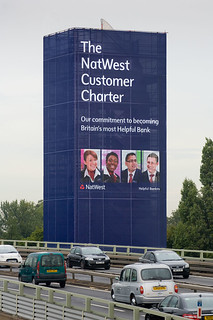 Yesterday’s problems at the Royal Bank of Scotland during the busiest shopping period of the year were a signal to us all. The bank suffered a system “meltdown” meaning that no-one could use any of the bank’s credit cards or debit cards. It caused no-end of issues. For instance, I woke up this morning to hear a woman on the radio saying how she had been arguing with a taxi driver who she had tried paying with her debit card which failed to work. She couldn’t even get cash out with it. The taxi driver, of course, was angry; he didn’t appreciate it was not his passenger’s fault.
Yesterday’s problems at the Royal Bank of Scotland during the busiest shopping period of the year were a signal to us all. The bank suffered a system “meltdown” meaning that no-one could use any of the bank’s credit cards or debit cards. It caused no-end of issues. For instance, I woke up this morning to hear a woman on the radio saying how she had been arguing with a taxi driver who she had tried paying with her debit card which failed to work. She couldn’t even get cash out with it. The taxi driver, of course, was angry; he didn’t appreciate it was not his passenger’s fault.
Meanwhile online, thousands of NatWest, RBS and Ulster Bank customers missed out on special one-day only discounts offered by Cyber Monday traders. The Royal Bank of Scotland has apologised and offered compensation. But that is little comfort to people who have missed out on the one thing they rely on with their credit and debit cards – convenience.
Imagine if you wanted to buy something online and you pressed the “Buy Now” button only to be presented with directions to an office where you could take your cash. Then once they had received your cash and banked it they would send out your goods. That cash office might be a hundred miles away, of course, perhaps even in a different country. Online retail would collapse.
The fact that you can pay right now, instantly, using a variety of systems from debit cards and credit cards to PayPal accounts or instant bank transfers means that online shopping survives because we can conveniently pay for what we want. People don’t use NatWest debit cards because they love the Royal Bank of Scotland, in spite of what their branding people might say. People use those cards because the bank they got it from was convenient to get to and using them is convenient – or at least until last night it was.
But what is “convenience” anyway? The dictionary tells us that something is convenient if it fits in with our needs and behaviours. In other words, we perceive something as convenient when it is focused on us as individuals and our specific requirements.
PayPal may be convenient for some people, but for others it is not convenient because it does not fit with their desire for using a British company, for instance. Equally, a Barclaycard is only convenient if you have a good credit score. Convenience does not mean just that it is easy, it means that it has what you might call “goodness of fit” with us as an individual.
So, for website owners the convenience question is important to consider. Does your website demonstrate convenience for your specific customers? After all, if your customers are the kind of people that prefer to pay by cheque, but you offer only PayPal, then no matter how convenient that might seem to you, it is not convenient to them. Yesterday with the RBS problems the apparent convenience of a debit card was laughed at by the millions of people who find cash much more convenient. It is horses for courses.
There are other issues about convenience of your website, in addition to whether or not it is tailored precisely to your customer needs. For example, can they find the search box? Is it “conveniently” located, which means in the place where people always look for it on web pages (centre or top right)? Is the shopping cart “convenient” – which means it also needs to be top right and uses as few clicks as possible. In other word, convenience is also about website functions and design decisions.
Far too many websites appear to think “convenience” is about “Buy Now” buttons and quick delivery. It is much, much more than this – as the Royal Bank of Scotland found out yesterday.
[box]Convenience is the first part of my CLICK System, a five-step method of ensuring your website really works. The CLICK System is explored in my new book, Click.ology, due out next month.[/box]

